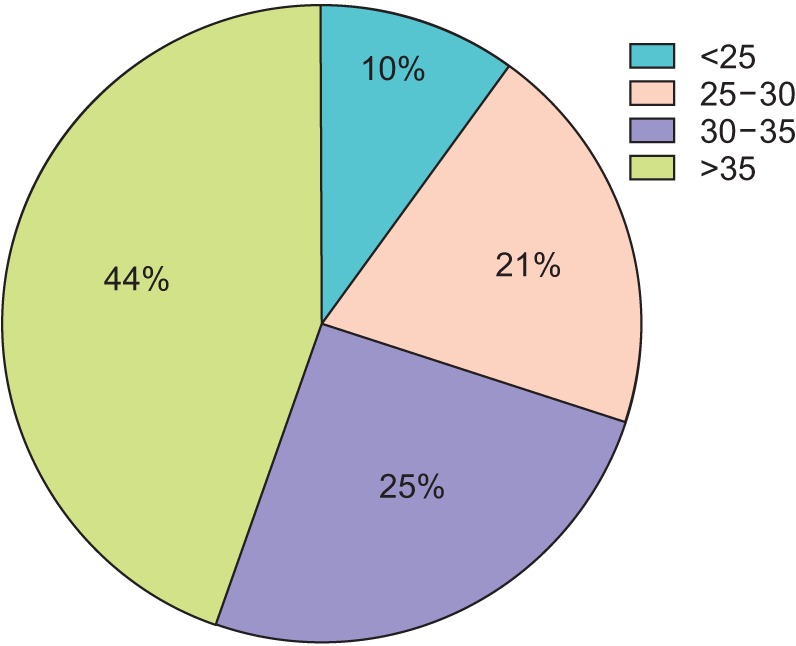Investig Clin Urol.
2016 May;57(3):202-207. 10.4111/icu.2016.57.3.202.
Diversity of patient profile, urethral stricture, and other disease manifestations in a cohort of adult men with lichen sclerosus
- Affiliations
-
- 1Department of Urology, University of Michigan, Ann Arbor, MI, USA. bmalaeb@med.umich.edu
- KMID: 2426495
- DOI: http://doi.org/10.4111/icu.2016.57.3.202
Abstract
- PURPOSE
Lichen sclerosus (LS) in men is poorly understood. Though uncommon, it is often severe and leads to repeated surgical interventions and deterioration in quality of life. We highlight variability in disease presentation, diagnosis, and patient factors in male LS patients evaluated at a tertiary care center.
MATERIALS AND METHODS
We retrospectively reviewed charts of male patients presenting to our reconstructive urology clinic with clinical or pathologic diagnosis of LS between 2004 and 2014. Relevant clinical and demographic information was abstracted and descriptive statistics calculated. Subgroup comparisons were made based on body mass index (BMI), urethral stricture, and pathologic confirmation of disease.
RESULTS
We identified 94 patients with clinical diagnosis of LS. Seventy percent (70%) of patients in this cohort had BMI >30 kg/m2, and average age was 51.5 years. Lower BMI patients were more likely to suffer from urethral stricture disease compared to overweight counterparts (p=0.037). Patients presenting with stricture disease were more likely to be younger (p=0.003). Thirty percent (30%) of this cohort had a pathologic diagnosis of LS.
CONCLUSIONS
Urethral stricture is the most common presentation for men with LS. Many patients endure skin scarring and have numerous comorbidities. Patient profile is diverse, raising the concern that not all patients with clinical diagnosis of LS are suffering from identical disease processes. The rate of pathologic confirmation at a tertiary care institution is alarmingly low. Our findings support a role for increased focus on pathologic confirmation and further delineation of the subtype of disease based on location and clinical manifestations.
MeSH Terms
Figure
Reference
-
1. Tausch TJ, Peterson AC. Early aggressive treatment of lichen sclerosus may prevent disease progression. J Urol. 2012; 187:2101–2105. PMID: 22503028.
Article2. Liu JS, Walker K, Stein D, Prabhu S, Hofer MD, Han J, et al. Lichen sclerosus and isolated bulbar urethral stricture disease. J Urol. 2014; 192:775–779. PMID: 24657836.
Article3. Farrar CW, Dowling P, Mendelsohn SD. Peristomal lichen sclerosus developing posturostomy. Clin Exp Dermatol. 2003; 28:223–224. PMID: 12653720.
Article4. Bjekic M, Sipetic S, Marinkovic J. Risk factors for genital lichen sclerosus in men. Br J Dermatol. 2011; 164:325–329. PMID: 20973765.5. Nelson DM, Peterson AC. Lichen sclerosus: epidemiological distribution in an equal access health care system. J Urol. 2011; 185:522–525. PMID: 21168879.
Article6. Becker K, Meissner V, Farwick W, Bauer R, Gaiser MR. Lichen sclerosus and atopy in boys: coincidence or correlation? Br J Dermatol. 2013; 168:362–366. PMID: 22860989.
Article7. Lester EB, Swick BL. Eosinophils in biopsy specimens of lichen sclerosus: a not uncommon finding. J Cutan Pathol. 2015; 42:16–21. PMID: 25404144.
Article8. Gambichler T, Belz D, Terras S, Kreuter A. Humoral and cellmediated autoimmunity in lichen sclerosus. Br J Dermatol. 2013; 169:183–184. PMID: 23301780.
Article9. Guerrero-Setas D, Perez-Janices N, Ojer A, Blanco-Fernandez L, Guarch-Troyas C, Guarch R. Differential gene hypermethylation in genital lichen sclerosus and cancer: a comparative study. Histopathology. 2013; 63:659–669. PMID: 23998425.
Article10. Pilatz A, Altinkilic B, Schormann E, Maegel L, Izykowski N, Becker J, et al. Congenital phimosis in patients with and without lichen sclerosus: distinct expression patterns of tissue remodeling associated genes. J Urol. 2013; 189:268–274. PMID: 23174236.
Article11. Philippou P, Shabbir M, Ralph DJ, Malone P, Nigam R, Freeman A, et al. Genital lichen sclerosus/balanitis xerotica obliterans in men with penile carcinoma: a critical analysis. BJU Int. 2013; 111:970–976. PMID: 23356463.
Article12. Hofer MD, Meeks JJ, Mehdiratta N, Granieri MA, Cashy J, Gonzalez CM. Lichen sclerosus in men is associated with elevated body mass index, diabetes mellitus, coronary artery disease and smoking. World J Urol. 2014; 32:105–108. PMID: 23633127.
Article13. Stewart L, McCammon K, Metro M, Virasoro R. SIU/ICUD Consultation on Urethral Strictures: Anterior urethra-lichen sclerosus. Urology. 2014; 83(3 Suppl):S27–S30. PMID: 24268357.
Article14. Hartley A, Ramanathan C, Siddiqui H. The surgical treatment of Balanitis Xerotica Obliterans. Indian J Plast Surg. 2011; 44:91–97. PMID: 21713168.
Article15. Xu YM, Feng C, Sa YL, Fu Q, Zhang J, Xie H. Outcome of 1-stage urethroplasty using oral mucosal grafts for the treatment of urethral strictures associated with genital lichen sclerosus. Urology. 2014; 83:232–236. PMID: 24200196.
Article16. Liu JS, Han J, Said M, Hofer MD, Fuchs A, Ballek N, et al. Long-term outcomes of urethroplasty with abdominal wall skin grafts. Urology. 2015; 85:258–262. PMID: 25530396.
Article17. Fistarol SK, Itin PH. Diagnosis and treatment of lichen sclerosus: an update. Am J Clin Dermatol. 2013; 14:27–47. PMID: 23329078.


